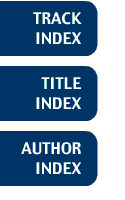
Track: Agriculture
A GIS-Based Agricultural Disaster Evaluation System

Sun LingZhu Zesheng , Guan Hengshen
The agricultural industry today is more complex, dynamic, and competitive. Many factors, such as biology, weather, disaster, economics, and marketing, interactively influence this business. In recent years, agricultural disaster evaluation systems (ADESs) have been widely researched and quickly developed. It not only is playing a more important role, but also has become a very important tool to manage modern agricultural production. However, how to reasonably apply various existent information processing techniques for designing and implementing a high-quality ADES has been a very important and interesting problem in agricultural production management. Unfortunately, the number of existent ADESs not only is much limited, but their function and quality are usually unsatisfactory in many applications of agricultural disaster evaluation. This fact shows that ADES design and implementation is also a complex and difficult task for most agricultural applications. The major reason resulting in the situation is that ADES must process a lot of spatial information relevant to agricultural disasters (especially including some random or undetermined factors) and provide good decision information for its users. A number of practical experiences have shown that such ADES requires a flexible and powerful GIS environment or framework for supporting its design and implementation. Further, our research on ADES has shown that a new GIS-based method can be used for designing and implementing a high-quality ADES. An ArcView GIS-based environment may be the best method. In fact, ArcView GIS is really an excellent performance GIS framework to design and implement ADES. In this paper, we present how to build ADES in the GIS environment by the method. Two key ADES-related information processing techniques (simulation and expert system [ES]) can be effectively integrated in the ArcView GIS-based environment. The ADES not only makes use of these techniques as fully as possible, but also has much better performance. Some of its obvious advantages include simple implementation, easy application, and maintenance. Otherwise, this paper also illustrates some basic function modules of a typical ADES including collecting historical and current data about agricultural disasters, processing the data, generating related decisions, and analyzing the decision precision. The ADES was developed on a PC under the ArcView GIS system using Visual Basic, Visual C++, and Avenue languages. Our successes show that the shift from early database-based ADES development toward a GIS-based one is a profound one in design and implementation of current and future ADESs. In summary, some major steps of our method application are the following: scoping of the ADES development project, in which the project area, requirements, and relevant spatial variables are defined by the ADES plan objective based on ADES user requirements and spatial variable operation rules; collecting data relevant to spatial variables in the ADES application field, in which these data must be represented as spatial variable form; developing, evaluating, and selecting all important logical relationships between the spatial variables, in which the relationships are used to build the basic architecture of the ADES model; integrating the relationships and the data relevant to spatial variables in GIS with simulation models and expert systems, in which the final ADES is built; refining this ADES; and improving its performance according to user requirements and practical applications.
Sun Ling
JiangSu Academy of Agricultural Sciences
JiangSu Academy of Agricultural Sciences
Nanjing, JIANGSU 210014
P. R., CHINA
Telephone: +86-0254438285
Fax: +86-0254390185
E-mail: jaasm@public1.ptt.js.cn